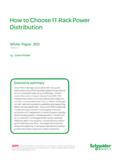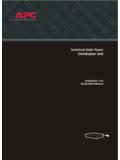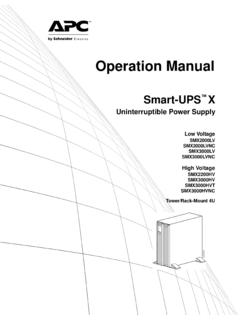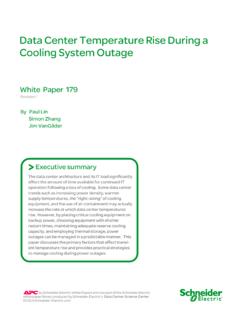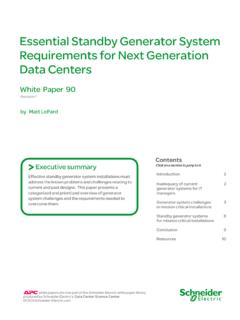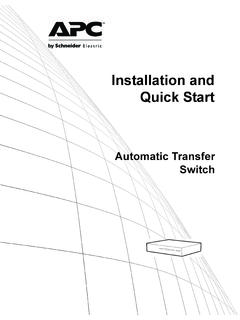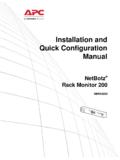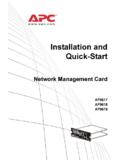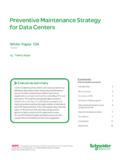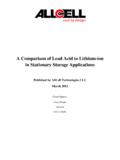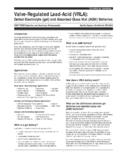Transcription of Battery pack containing sealed lead acid batteries ...
1 Battery pack containing sealed lead acid batteries MATERIAL safety DATASHEET. Version: 1. Review date: October, 13th 2015. SECTION 1: Identification of the Substance/Mixture and of the Company/Undertaking GHS product Battery pack containing sealed lead acid batteries identifier: Battery pack or accumulator pack with Valve Regulated Lead acid Battery - Wet, Non- Other Names: Spillable APC-RBCXXX(L)(-AAA) or SYBTXXX(-AAA) (where XXX is 001 through 999 and APC, L, -AAA. Model Numbers: are optional and AAA is a two or three letter customer or country code) or YYYY(XXX)BP. (where YYYY is SU, SUA, SCR, SRT, UX, UXA or SURT and XXX is 24, 48 or 192). Country: USA / CANADA. Battery pack is a manufactured article consisting of a plastic and metal sealed case Product Type: containing one or more sealed lead acid Battery connected by wires. Solid. Identified uses Relevant identified use(s): Electric Storage Battery Use(s) advised against: Transportation Manufacturer Supplier/Manufacturer: APC by Schneider Electric Address: 132 Fairgrounds Road West Kingston, RI 02892 United States Telephone: 800-788-2208 or 401-789-5735.
2 Website: Emergency telephone number (with hours of operation). 800-788-2208. SECTION 2: Hazards identification United States (US). According to OSHA 29 CFR HCS. Classification of the substance or mixture: Skin Corrosion 1A - H314. Serious Eye Damage 1 - H318. Carcinogenicity 2 - H351. Reproductive Toxicity 1A - H360. Specific Target Organ Toxicity Repeated Exposure 1 - H372. GHS label elements: Signal Word: DANGER. Battery pack containing sealed lead acid batteries Page 1 to 14. Version: 1. Date: October, 13th, 2015. Hazard Statements: H314 Causes severe skin burns and eye damage. H318 Causes serious eye damage. H351 Suspected of causing cancer. H360 May damage fertility or the unborn child. H372 Causes damage to organs - nervous system/blood/liver/kidneys through prolonged or repeated exposure. Precautionary statements Prevention P201 Obtain special instructions before use P202 Do not handle until all safety precautions have been read and understood. P260 Do not breathe mist/vapours/spray P264 Wash thoroughly after handling P270 Do not eat, drink or smoke when using this product.
3 P280 Do not eat, drink or smoke when using this product. - Response IF INHALED: Remove victim to fresh air and keep at rest in a position comfortable for P304+P340. breathing. IF ON SKIN (or hair): Take off immediately all contaminated clothing. Rinse skin with P303+P361+P353. P310 Immediately call a POISON CENTER or doctor/physician P321 Specific treatment, see supplemental first aid information. P363 Wash contaminated clothing before reuse. IF IN EYES: Rinse cautiously with water for several minutes. Remove contact lenses, if P305+P351+P338. present and easy to do. Continue rinsing. P301+P330+P331 IF SWALLOWED: Rinse mouth. Do NOT induce vomiting P308+P313 IF exposed or concerned: Get medical advice/attention. P314 Get medical advice/attention if you feel unwell Storage/Disposal P405 Store locked up. Dispose of content and/or container in accordance with local, regional, national, and/or P501. international regulations Other hazards OSHA HCS 2012: Under United States Regulations (29 CFR - Hazard Communication Standard), this product is considered hazardous.
4 Battery pack containing sealed lead acid batteries Page 2 to 14. Version: 1. Date: October, 13th, 2015. Canada According to WHMIS. Classification of the substance or mixture: Very Toxic - D1A. Other Toxic Effects - D2A. Corrosive - E. GHS label elements: Other Hazards In Canada, the product mentioned above is considered hazardous under the Workplace Hazardous Materials Information System (WHMIS). Other Information acid batteries used in APC by Schneider Electric Replacement Battery Cartridges (RBCs) are contained within cartridges and are sealed , non-spillable design. Under normal use and handling, there is no contact with the internal components of the Battery or the chemical hazards. Under normal use and handling, these products do not emit regulated or hazardous substances. Misuse of the product, such as overcharging, may result in a discharge of Battery electrolyte. Classification provided is for the Battery electrolyte and are only applicable in the event that the electrolyte is discharged.
5 SECTION 3: Composition/information on ingredients Substances The material does not meet the criteria of a substance in accordance with regulation (EC) No 1272/2008. Classification OSHA. Chemical Name CAS Number EC Number Composition (%) LD50/LC50. HCS 2012. Repr. 1A; STOT RE 1. (Liver, Kidney, Blood, Lead 7439-92-1 231-100-4 55,9 63,4 % NO DATA AVAILABLE. Nervous system); Carc. 2. Inhalation-Rat LC50 . 510 mg/m 2 Hour(s) Eye Dam. 1; Skin Corr. Sulfuric acid 7664-93-9 231-639-5 15,8 20,5 %. Ingestion/Oral-Rat 1A. LD50 2140 mg/kg 1-Propene, Ingestion/Oral-Rat 9003-07-0 -- 4,8 12,3 % Not Classified homopolymer LD50 >8 g/kg Amorphous/fused 60676-86-0 -- 3,7 5,6 % NO DATA AVAILABLE Not Classified silica Polyvinyl Chloride 9002-86-2 -- 2,6 % NO DATA AVAILABLE Not Classified Repr. 2, STOT SE 3: Copper 7440-50-8 231-159-6 2,6 % NO DATA AVAILABLE. Resp. Irrit.; Eye Irrit. 2;. Steel -- -- 0,4 % NO DATA AVAILABLE Not Classified Battery pack containing sealed lead acid batteries Page 3 to 14. Version: 1.
6 Date: October, 13th, 2015. STOT SE 3: Resp. Irrit.;. STOT RE 2 (Lungs, Tin 7440-31-5 231-141-8 0,3 % NO DATA AVAILABLE. Inhalation); STOT RE 1. (CNS, Liver, Kidney). Polycarbonate 27440-31-5 -- 0,1 % NO DATA AVAILABLE Not Classified See Section 11 for Toxicological Information. See Section 16 for full text of H-statements and R-phrases. SECTION 4: First aid measures Description of first aid measures IF INHALED: Remove victim to fresh air and keep at rest in a position comfortable for breathing. Administer oxygen if breathing is difficult. Give artificial respiration if victim is not breathing. Do Inhalation not use mouth-to-mouth method if victim inhaled the substance; give artificial respiration with the aid of a pocket mask equipped with a one-way valve or other proper respiratory medical device. IF ON SKIN: Wash with plenty of soap and water. Take off contaminated clothing and wash before Skin reuse. If signs/symptoms develop, get medical attention. IF IN EYES: Rinse cautiously with water for several minutes.
7 Remove contact lenses, if present Eye and easy to do. Continue rinsing. If signs/symptoms develop, get medical attention. Do NOT induce vomiting. If conscious, drink large quantities of milk or water. Follow with milk of Ingestion magnesia, beaten egg, egg whites or vegetable oil. Get medical attention immediately. Most important symptoms and effects, both acute and delayed Refer to Section 11 - Toxicological Information Indication of any immediate medical attention and special treatment needed Notes to Physician: All treatments should be based on observed signs and symptoms of distress in the patient. Consideration should be given to the possibility that overexposure to materials other than this product may have occurred. SECTION 5: Fire-fighting measures Extinguishing media Suitable Extinguishing Media Dry chemical or CO2. Water should not be used unless from a safe distance due to vigorous and Unsuitable Extinguishing Media exothermic reaction which will result. Special hazards arising from the substance or mixture Hydrogen and oxygen gases are produced during normal Battery operation and Unusual Fire and Explosion charging.
8 These gases escape through the Battery vents and may form an explosive Hazards atmosphere around the Battery if ventilation is poor. Avoid open flame, sparks and other ignition sources in areas where batteries are used or stored. Hazardous Combustion acid mists and vapors, toxic fumes from burning plastic. Products Advice for firefighters Fire fighters should wear complete protective clothing including self-contained breathing apparatus. Wear chemical protective clothing that is specifically recommended by the manufacturer. It may provide little or no thermal protection. Fire fighters to wear acid -resistant full protective clothing, including rubber footwear and self-contained breathing apparatus. Battery pack containing sealed lead acid batteries Page 4 to 14. Version: 1. Date: October, 13th, 2015. SECTION 6: Accidental release measures Personal precautions, protective equipment and emergency procedures Do not walk through spilled material. Wear appropriate personal protective equipment, avoid direct contact.
9 Do not touch damaged containers or spilled Personal Precautions material unless wearing appropriate protective clothing. Ventilate enclosed areas. Do not get in eyes, on skin, or on clothing. Do not breathe dusts or mists. As an immediate precautionary measure, isolate spill or leak area for at least 50. Emergency Procedures meters (150 feet) in all directions. Keep unauthorized personnel away. Do not get water inside container. Environmental precautions Avoid run off to waterways and sewers. Methods and material for containment and cleaning up Stop leak if you can do it without risk. If Battery is leaking, place Battery in a Containment/Clean-up heavy duty plastic bag. Contain spill by diking with soda ash, etc. Neutralize spill Measures area with (soda ash or lime, dilute with acetic acid ) Make certain mixture is neutral then collect residue and place in a drum or other suitable container. Reference to other sections Refer to Section 8 - Exposure Controls/Personal Protection and Section 13 Disposal Considerations SECTION 7: Handling and storage Precautions for safe handling Handling: Use only in well ventilated areas.
10 Use caution when combining with water; DO NOT add water to corrosive liquid, ALWAYS add corrosive liquid to water while stirring to prevent release of heat, steam and fumes. Wear appropriate personal protective equipment, avoid direct contact. Do not get in eyes, on skin, or on clothing. Do not breathe mist, vapors, spray. Avoid direct conductive connection across positive and negative terminals to prevent short circuit. Wash thoroughly with soap and water after handling and before eating, drinking, or using tobacco. Conditions for safe storage, including any incompatibilities batteries should be kept in an upright position away from ignition sources. Stack batteries so as to prevent accidental contact between terminal and/or other damage to terminals or containers. Whenever feasible, store on shipping pallet or rack. Do not stack loaded pallets or racks on top of other batteries . Store in a cool/low temperature, well- ventilated place. Avoid storage in areas exposed to heat or solar buildup Specific end use(s).
